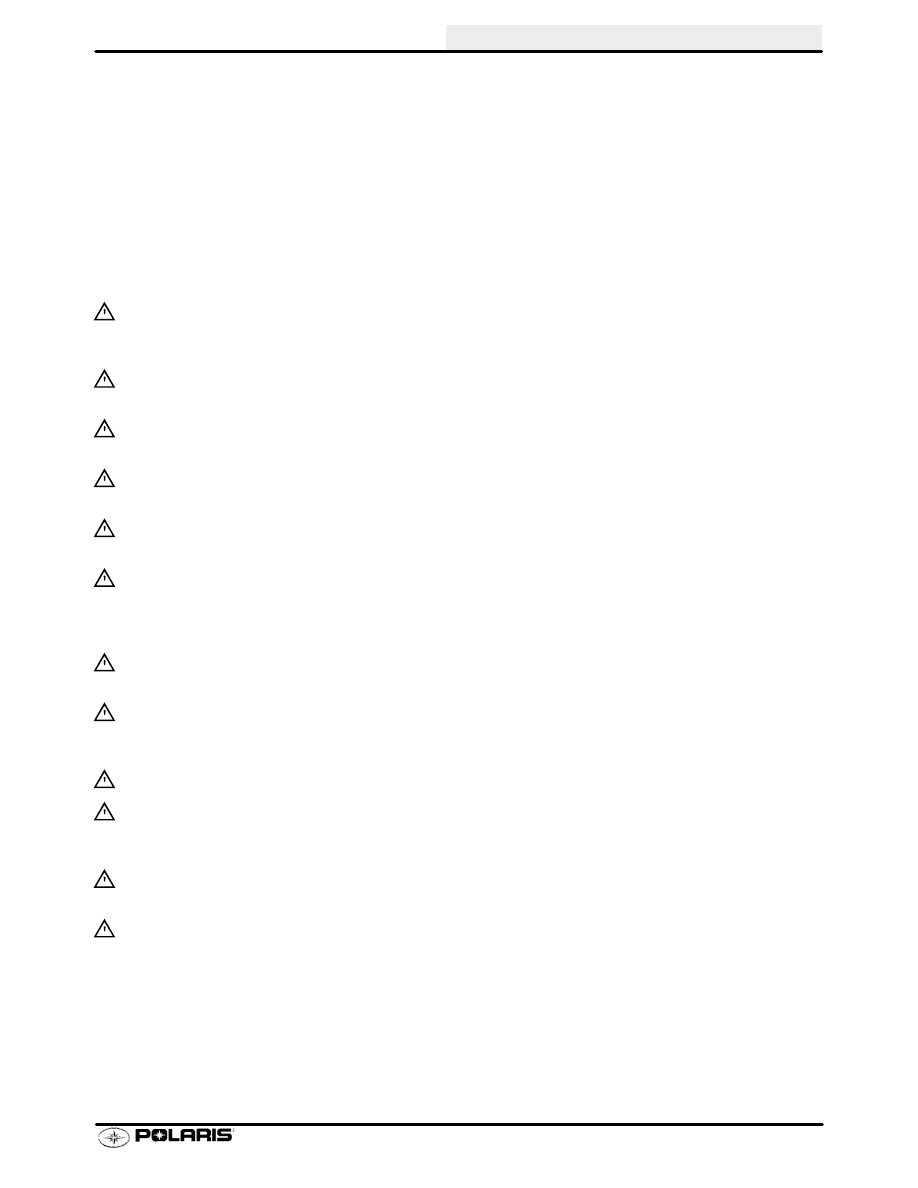Snowmobile Polaris High Performance (2001 year). Manual - part 11

GENERAL INFORMATION
1.41
Handling Problems
Handling problems usually require several changes in setup to correct. Most problems can be traced to improper
suspension adjustment. If the problem is encountered when entering a corner, adjust the front end. If the problem
is encountered when exiting a corner, adjust the rear suspension.
Service
In order to perform service work efficiently and to prevent costly errors, the technician should read the text in this
manual, thoroughly familiarizing him/herself with procedures before beginning. Pictures and illustrations have
been included with the text as an aid. Notes, cautions and warnings have also been included for clarification of text
and safety concerns. However, a knowledge of mechanical theory, tool use and shop procedures is necessary to
perform the service work safely and satisfactorily. Use only genuine Polaris service parts.
Cleanliness of parts and tools as well as the work area is of primary importance. Dirt and foreign matter will act
as an abrasive and cause damage to precision parts. Clean the snowmobile before beginning service. Clean new
parts before installing.
Watch for sharp edges which can cause personal injury, particularly in the area of the tunnel. Protect hands
with gloves when working with sharp components.
If difficulty is encountered in removing or installing a component, look to see if a cause for the difficulty can be
found. If it is necessary to tap the part into place, use a soft face hammer and tap lightly.
Some of the fasteners in the snowmobile were installed with locking agents. Use of impact drivers or
wrenches will help avoid damage to fasteners.
Always follow torque specifications as outlined throughout this manual. Incorrect torquing may lead to serious
machine damage or, as in the case of steering components, can result in injury or death for the rider(s).
If a torquing sequence is indicated for nuts, bolts or screws, start all fasteners in their holes and hand tighten.
Then, following the method and sequence indicated in this manual, tighten evenly to the specified torque value.
When removing nuts, bolts or screws from a part with several fasteners, loosen them all about 1/4 turn before
removing them.
If the condition of any gasket or O-Ring is in question, replace it with a new one. Be sure the mating surfaces
around the gasket are clean and smooth in order to avoid leaks.
Some procedures will require removal of retaining rings or clips. Because removal weakens and deforms
these parts, they should always be replaced with new parts. When installing new retaining rings and clips use care
not to expand or compress them beyond what is required for installation.
Because removal damages seals, replace any oil or grease seals removed with new parts.
Polaris recommends the use of Polaris lubricants and greases, which have been specially formulated for the
top performance and best protection of our machines. In some applications, such as the engine, warranty
coverage may become void if other brands are substituted.
Grease should be cleaned from parts and fresh grease applied before reassembly of components.
Deteriorating grease loses lubricity and may contain abrasive foreign matter.
Whenever removing or reinstalling batteries, care should be taken to avoid the possibility of explosion
resulting in serious burns. Always disconnect the negative (black) cable first and reconnect it last. Battery
electrolyte contains sulphuric acid and is poisonous! Serious burns can result from contact with the skin, eyes or
clothing. ANTIDOTE: External - Flush with water. Internal - Drink large quantities or water or milk. Follow with
milk of magnesia, beaten egg, or vegetable oil. Call physician immediately. Eyes - Flush with water for 15 minutes
and get prompt medical attention.